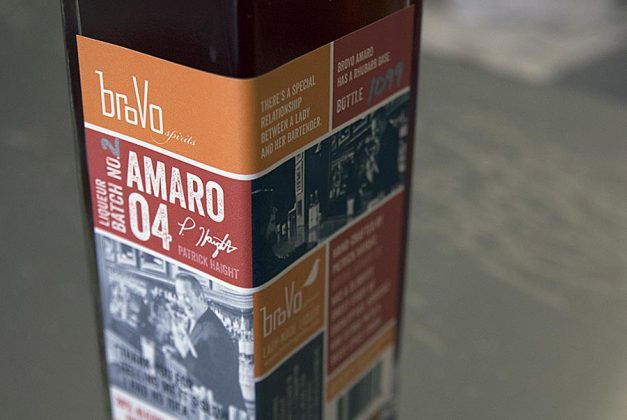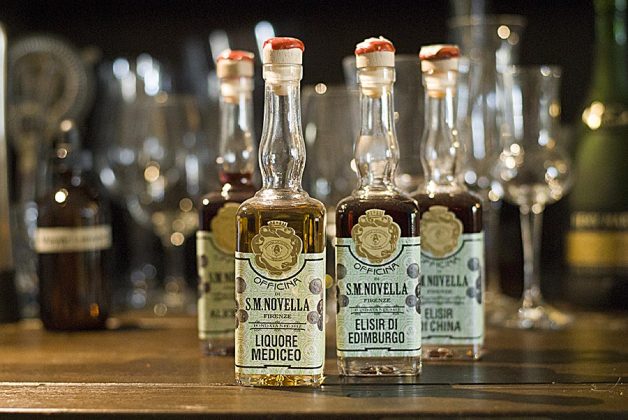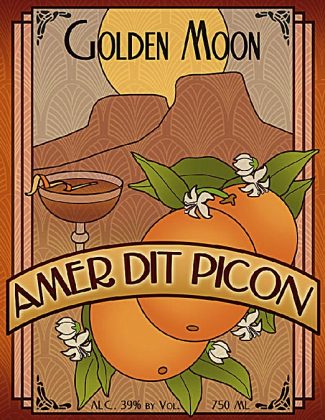Some flavors appear to appeal to us from childhood, from the salty snap of chips and pretzels to the luscious sweetness of fruit and chocolate. But as every espresso-sipping, kimchi-munching grownup can attest, some flavors take a while to grow on us. Among American bartenders and drinkers, bitterness is the taste that is increasingly being acquired, and craft distillers are discovering the magnificent range of options that the class of potable bitters can offer.
In this exploration of bitter’s boundaries, these distillers are covering ground long familiar to Europeans. Called amari in Italy (the plural of amaro, which translates as “bitter”) and amer in France, bitter liqueurs have a legacy that, in some cases, stretches back centuries. That makes for a lot of catching up to do by American craft distillers, and as some develop recipes based on the study of distillers’ notebooks and archives from generations past, others are turning the amaro model in a distinctively New World direction.
Stephen Gould at Golden Moon Distillery in Colorado is among those finding the beauty in bitter. Inspired by his work with absinthe — another history-rich European botanical spirit embraced by American distillers — Gould says the appeal of making his own amaro proved irresistible. “It was only after I started playing around with absinthe about 10 years ago that my entire view of what distilling was, and could be, changed,”
Gould says.
Gould was also drawn to amaro from his memories of growing up among a large Basque community in northern Nevada. Like similar communities in central California and Idaho, the Basques retained a Southern European tradition of sipping bitter liqueurs, in particular a French product called Amer Picon that’s frequently mixed in a highball-type drink called Picon Punch.
Amer Picon was developed in the 1830s by apothecary Gaetan Picon while serving in the French army in North Africa. As was the case with the development of many other botanical-rich amers and amari, Picon’s pursuit was medicinal: the French colonies were ravaged by malaria, and a tonic prepared with cinchona bark (from which quinine is derived) was needed to combat the disease. To balance cinchona’s crisp bitterness, Picon added flavorful ingredients such as orange peel and spices, creating a liqueur that was eventually embraced by French drinkers who viewed it as a recreational pleasure rather than a medicinal necessity.
Still widely available in France, Amer Picon has been spottily imported into the United States (it’s currently unavailable), though it made enough of a presence around the early 1900s that the product appeared as an ingredient in a number of Manhattan-like cocktails, including the Brooklyn and the Liberal. A 20th century reformulation decreased the liqueur’s proof and somewhat altered its flavor, and Gould saw an opportunity to not only introduce a product that hewed closely to Picon’s original formula, but to provide craft bartenders with an otherwise unobtainable product useful for the preparation of classic cocktails. “I wanted to bring back something that hadn’t existed in 75 years—at least, not in its original form,” Gould says.
Gould’s research took him into his extensive personal library of distillation books and journals dating to the early 19th century, and he tested a few recipes published from the late 1800s to around 1926. “They were okay, but different,” Gould says. Eventually, while digging through handwritten notebooks, he found a rough recipe from 1850—written not long after development of the original Amer Picon formula in the 1830s—and the formulation seemed promising. With translation and interpretation assistance from Anna Pickerell—the daughter of influential distiller Dave Pickerell, and a chemical engineer in her own right—Gould assembled a workable process to reformulate the defunct version of Amer Picon, which he’s dubbed Amer dit Picon.
The original 9-step process included a series of infusions, distillations and heat maceration of botanicals. Gould’s ingredients include four types of citrus (among them, notably, the bitter curacao orange, which is a defining flavor of the drink), along with a host of medicinal herbs and botanicals such as cinchona bark. Gould did make one exception while otherwise hewing to the early formula: he did not include calamus root, an ingredient considered unsafe by the FDA.
A taste test between Amer dit Picon and a sample of original Amer Picon taken from a pre-reformulation bottle revealed the absence of calamus root made little noticeable difference, Gould says. “I tasted it and compared it to a 100-plus-year-old Amer Picon, and it tasted very, very similar,” Gould says. “Mine was a little more peppery, and a little hotter, but that’s understandable when you think that the bottle has been sitting around for a number of years. The product we are now making is, I believe, as close as what Picon made in the 1800s—and it makes one hell of a Brooklyn cocktail, and one hell of a Picon Punch.”
Amer Picon may be a mystery to many American drinkers, but other classic European bitters are more familiar. Campari, an Italian aperitif bitter as recognizable for its bright garnet color as for its orange peel-inflected bite, is among the world’s most popular potable bitters. Other Italian exports include Aperol, a low-alcohol aperitif bright with rhubarb; rich, gentle amari with tones of cola and chocolate, such as Averna, Amaro Nonino and Amaro Montenegro; and Fernet Branca, a Milanese liqueur flavored with eucalyptus and mint, that is so brusquely bitter that novices may feel the need to establish a safe word with the bartender before sipping a first shot. While the Italians excel at amari, other cultures also evince a taste for bitter, as seen with the dark and earthy Unicum, from Hungary; the cinnamon-accented Becherovka, from the Czech Republic; and the immensely popular Jagermeister, from Germany.
Like familiar nonpotable cocktail bitters such as Angostura, amari and their ilk are prepared using a wide range of herbs, spices, barks and other botanicals, selected to create a complex flavor with a bold bitterness at its core. Potable bitters, however, are designed with a lighter hand on the bittering agent—cinchona bark, gentian and wormwood are among the traditional favorites—resulting in a product that’s sippable by the shot, rather than dispensed by the dropper.
Like other herbal drinks such as vermouth, Chartreuse and Benedictine, bitter liqueurs have a history that is rooted in the apothecary’s cabinet. Since the times of Pliny the Elder, medicinal herbs used to combat parasites, prevent disease, treat ailments or relieve gastric discomfort were commonly infused in a base of wine (or, following the advent of distillation, spirits). These infusions typically included the addition of spices, flowers, fruit peels and other ingredients selected for flavor (often to balance or mask the medicine’s bitterness), and were sweetened with sugar to—as Mary Poppins memorably noted—make the medicine go down. This history is still on display in places such as the old pharmacy of Santa Maria Novella in Florence, founded by Dominican friars in 1221. Still open today, Santa Maria Novella sells soaps and fragrances, as well as antiquarian-style amari such as the cinchona-spiked Elisir di China and the saffron-laced Elisir Stomatico.
Over time, many of these medicinals came to be appreciated for their flavor as well as their curative properties, and by the early 20th century, bitter liqueurs were making guest turns in cocktail bars in London, Paris and New York. These occasional appearances in drinks such as the Brooklyn or the Fernet Branca-accented Hanky Panky foreshadowed the flood of amari that are now being poured in craft-cocktail bars in cities ranging from Seattle to Houston to Boston.
In the Seattle suburb of Woodinville, broVo Spirits co-founder Mhairi Voelsgen noticed the rising tide of amari in bars, and began inviting area bartenders to the distillery to make their own imprint on the category. For Voelsgen, who saw opportunity in a wide-open category (and, in true lemons-to-lemonade fashion, was seeking a way to use $25,000 worth of rhubarb distillate from a recent project that had proved untenable), amari appealed to the creative side of distillers and bartenders.
“Amaro is wide open,” Voelsgen says. “It’s a bittersweet digestive: that’s the category. And making it is like jazz improv,” she says, noting that the production process requires a series of experimental steps that call for a little creative daredeviling and a lot of flexibility. The first stage may start with a weeks-long soak of mixes of botanicals stuffed into giant “teabags” (actually sweat socks tied with dental floss), but the follow-through may include shorter, overnight macerations of individual ingredients to correct or emphasize a flavor, and tinkering with the liqueur’s sweetness. “It’s not like you add the spice load, pull it out and you’re done,” she says. “You get to add hyperinfusions along the way to bring particular notes up, so you get into the creativity of it. There is no wrong answer with amaro.”
The first selection of seven liqueurs from broVo was released in early 2013. In working to create bitter liqueurs designed to be embraced by bartenders, broVo isn’t alone. New Orleans-based Bittermens, which was founded by Avery and Janet Glasser originally to create nonpotable bitters, has several cocktail-ready bitter liqueurs on the market, including a Picon-like Amère Nouvelle, an earthy gentian-flavored Amère Sauvage, and the latest release, Bäska Snaps, a Swedish-style bitter spirit.
These liqueurs are part of a rising tide of American amari, designed either to be sipped as an aperitif or digestif, or to be incorporated into cocktails. In Colorado, Leopold Bros. make Fernet Leopold, inspired by the Milanese classic, and Breckenridge Distillery produces its eponymous Breckenridge Bitters. Several distilleries have also made versions of the venerable Italian liqueur nocino, an inky-black and complexly bitter liqueur flavored with green walnuts, ranging from the Kuchan Nocino from Old World Spirits in California, to nocinos from Skip Rock Distillers and Sidetrack Distillery in Washington. And in Eugene, Oregon, the brisk spark of cinchona and the brightness of bitter oranges flavor Calisaya, a liqueur made in the Italian amaro tradition.
In Portland, House Spirits founder Christian Krogstad is developing an amaro in conjunction with New York bartender Toby Cecchini, for release in mid-2014. Krogstad says the new liqueur is still in the experimental stage, but is being designed to fill a gap in the amaro spectrum. “Everyone wants to be the next Fernet Branca or Jagermeister, but that ship has sailed,” Krogstad says. “We’re making a specific thing that doesn’t exist in the market—if it existed, we’d buy it and drink it, but it doesn’t, so we’ll make it. That’s the impetus.”
It’s not difficult to see the impetus for seasoned bartenders to engage with distillers in exploring the bitter arts. Mike Ryan, who heads the bar at Sable in Chicago, is among those participating in broVo’s second amari project, which invited bartenders from Chicago and San Francisco to create new amari. Ryan says the chance to make his own amaro was too good to pass up. “It’s gotten to the point where making your own bitters is de rigueur for a serious cocktail bar, but I’d never thought about doing my own amaro until Mhairi approached with the opportunity,” Ryan says.
For Ryan’s amaro, he took an established formula he’d been using for cocktail bitters at Sable and tweaked the recipe to produce a potable version. Flavored with chocolate, thyme and sarsaparilla and bittered with gentian, the amaro is designed to work well in cocktails mixed with the rich vanilla tones of aged bourbon or rum, as well as the ethereal headiness of unaged brandies such as pear eau de vie.
While Voelsgen left the choice of ingredients in the hands of her bartender partners, all of the participants so far have chosen gentian as the bittering botanical, rather than cinchona, quassia or wormwood. The choice was partly one of familiarity—cocktail bitters frequently include gentian as an ingredient, so it’s a known quantity to experienced bartenders—and partly out of regulatory convenience. “Gentian is pretty well understood by the FDA, so there’s not a ton of testing that needs to go on,” Ryan says. “In my original bitters, I was using wormwood and angelica, and a little quassia bark; but after consultation, it looked like it’d take a lot of testing from the FDA, and label approval would take longer.”
Ryan’s point underscores one of the hurdles new amari may encounter before hitting the market: the challenge of getting formulae approved by Federal regulators, especially liqueurs containing ingredients unfamiliar to many staffers. It’s a challenge familiar to Stephen Gould, who has first-hand experience with navigating the TTB bureaucracy.
“You need to be able to document where in the FDA regulations it lists each component as a safe food substance or additive,” Gould says. “If you don’t, the TTB will kick your formula back.” Gould notes that the authorization process has grown increasingly slow and complicated, thanks in large part to Federal sequester-related budget cuts, and that distillers need to be proactive in making the argument that their products are safe and meet all regulatory requirements. “The more work the distiller does in fleshing out the formula and making it so anybody who reads it knows the flavor and coloring components are safe and legal to use, the better chance you’ll have of getting it approved,” he says. “Do the extra legwork up front so the TTB desk doesn’t have to, because they may decide to just throw it back over the fence and say, ‘No.’”
Distillers such as Voelsgen and Gould are now discovering what American consumers may (or may not) be looking for when it comes to bitter liqueurs. The second round of broVo’s amari became available in October, joining some of the favorites from the first round of market release. The formula for Golden Moon Distillery’s Amer dit Picon received TTB approval in July, and as of this fall, Gould was awaiting label approval. Once his product hits the shelves, one of the places it will be poured is in Gould’s own bar in downtown Golden, scheduled to open in November and featuring a tasting room stocked with cocktail-ready spirits from the distillery—a lineup that may include other European-style bitters and herbal liqueurs that may only be available at the tasting room.
Making bitter liqueurs isn’t easy, and navigating regulatory approval is complicated—but Gould says the real challenge may come after the product is finished, as American distillers begin to discover whether consumers have actually acquired a taste for bitter. “Can I really sell this? It’s a difficult product to make, with a very labor-intensive process, and we’re competing with European products selling for $20 a bottle,” Gould says. “Whether I can make this and sell it profitably is a question I don’t know the answer to yet—but I intend to find out.”













